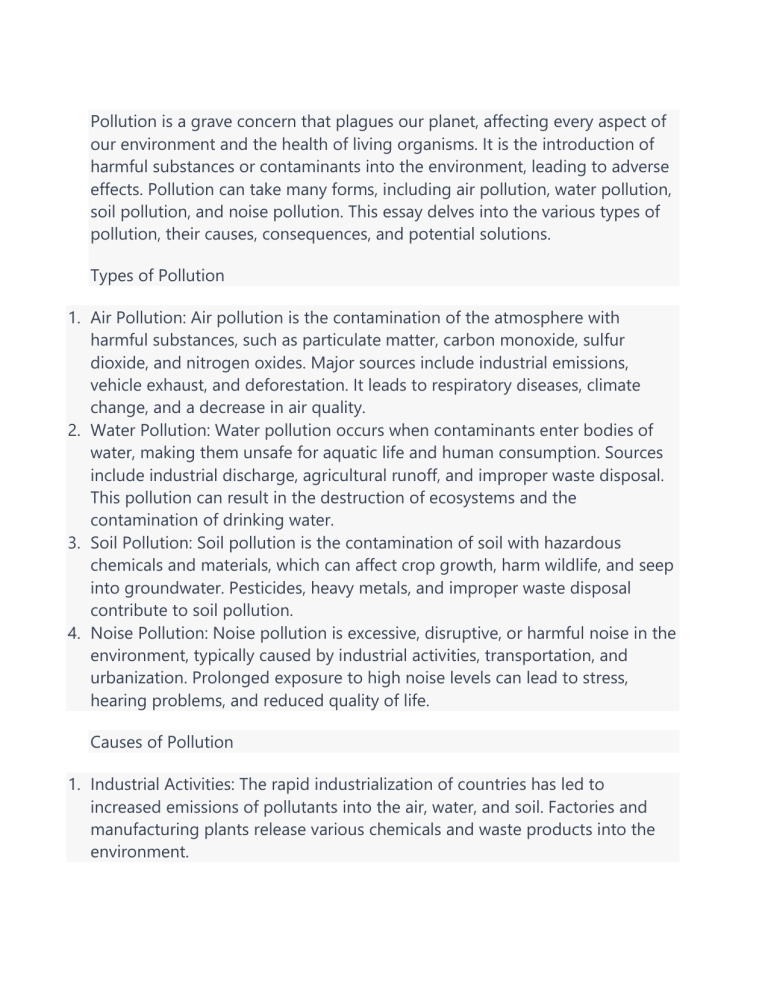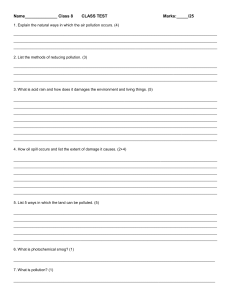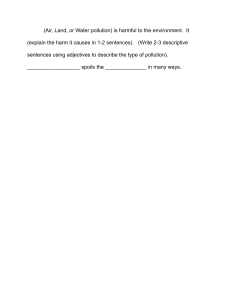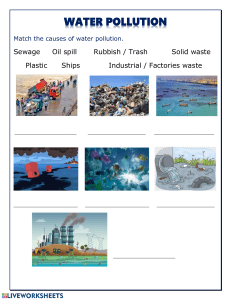
Pollution is a grave concern that plagues our planet, affecting every aspect of our environment and the health of living organisms. It is the introduction of harmful substances or contaminants into the environment, leading to adverse effects. Pollution can take many forms, including air pollution, water pollution, soil pollution, and noise pollution. This essay delves into the various types of pollution, their causes, consequences, and potential solutions. Types of Pollution 1. Air Pollution: Air pollution is the contamination of the atmosphere with harmful substances, such as particulate matter, carbon monoxide, sulfur dioxide, and nitrogen oxides. Major sources include industrial emissions, vehicle exhaust, and deforestation. It leads to respiratory diseases, climate change, and a decrease in air quality. 2. Water Pollution: Water pollution occurs when contaminants enter bodies of water, making them unsafe for aquatic life and human consumption. Sources include industrial discharge, agricultural runoff, and improper waste disposal. This pollution can result in the destruction of ecosystems and the contamination of drinking water. 3. Soil Pollution: Soil pollution is the contamination of soil with hazardous chemicals and materials, which can affect crop growth, harm wildlife, and seep into groundwater. Pesticides, heavy metals, and improper waste disposal contribute to soil pollution. 4. Noise Pollution: Noise pollution is excessive, disruptive, or harmful noise in the environment, typically caused by industrial activities, transportation, and urbanization. Prolonged exposure to high noise levels can lead to stress, hearing problems, and reduced quality of life. Causes of Pollution 1. Industrial Activities: The rapid industrialization of countries has led to increased emissions of pollutants into the air, water, and soil. Factories and manufacturing plants release various chemicals and waste products into the environment. 2. Transportation: The widespread use of automobiles, trucks, and airplanes contributes significantly to air pollution through the release of greenhouse gases and other pollutants. Inefficient transportation systems and congested cities worsen the problem. 3. Agriculture: The use of fertilizers, pesticides, and herbicides in agriculture can lead to water and soil pollution. These chemicals run off into nearby water bodies, affecting aquatic ecosystems and groundwater. 4. Deforestation: Clearing land for agriculture, urban development, and other purposes not only reduces the planet's green cover but also disrupts natural ecosystems and contributes to soil erosion. 5. Improper Waste Management: Inadequate waste disposal and the presence of landfills release harmful substances into the environment. Poorly managed waste also attracts pests and poses health risks to nearby communities. Consequences of Pollution 1. Health Impacts: Air pollution is linked to respiratory diseases, heart problems, and even premature death. Water pollution can cause waterborne diseases, while soil pollution can lead to contaminated crops and reduced agricultural yields. 2. Biodiversity Loss: Pollution has dire effects on ecosystems and biodiversity. Aquatic life, in particular, is vulnerable to the impacts of water pollution, leading to the decline of various species. 3. Climate Change: The release of greenhouse gases, such as carbon dioxide and methane, into the atmosphere contributes to global warming and climate change. This leads to rising temperatures, extreme weather events, and sea level rise. 4. Economic Costs: Pollution imposes significant economic burdens, including healthcare costs, environmental restoration, and lost productivity. It can also deter tourism and foreign investment. Solutions to Pollution 1. Regulatory Measures: Governments must enact and enforce stringent regulations to control pollution. These can include emission standards for industries, vehicle emissions testing, and penalties for non-compliance. 2. Alternative Energy Sources: Transitioning to cleaner energy sources like solar, wind, and hydroelectric power can reduce the emission of greenhouse gases from fossil fuels. 3. Sustainable Agriculture: Promoting sustainable agricultural practices, such as organic farming and reduced chemical usage, can minimize soil and water pollution. 4. Waste Management: Efficient waste management systems that include recycling and proper disposal are essential in curbing pollution. 5. Public Awareness: Education and awareness campaigns can motivate individuals to reduce their carbon footprint, conserve resources, and make environmentally conscious choices. Conclusion Pollution remains one of the most pressing global challenges of our time. It affects the health and well-being of both humans and the planet's ecosystems. To mitigate the consequences of pollution, concerted efforts from governments, industries, and individuals are needed. By adopting cleaner practices, enforcing regulations, and raising public awareness, we can collectively work toward a cleaner and healthier environment for future generations.




